The SAP Business Technology Platform (SAP BTP) refers to a unified suite of SAP tools, offerings, and services consolidated into a single, unified platform. It does not represent a standalone product and currently does not appear on any official pricing catalog. Instead, it combines cloud-based and on-site solutions, organized into four core technological categories: data storage and administration, business intelligence, software creation and system connectivity, and smart technologies.
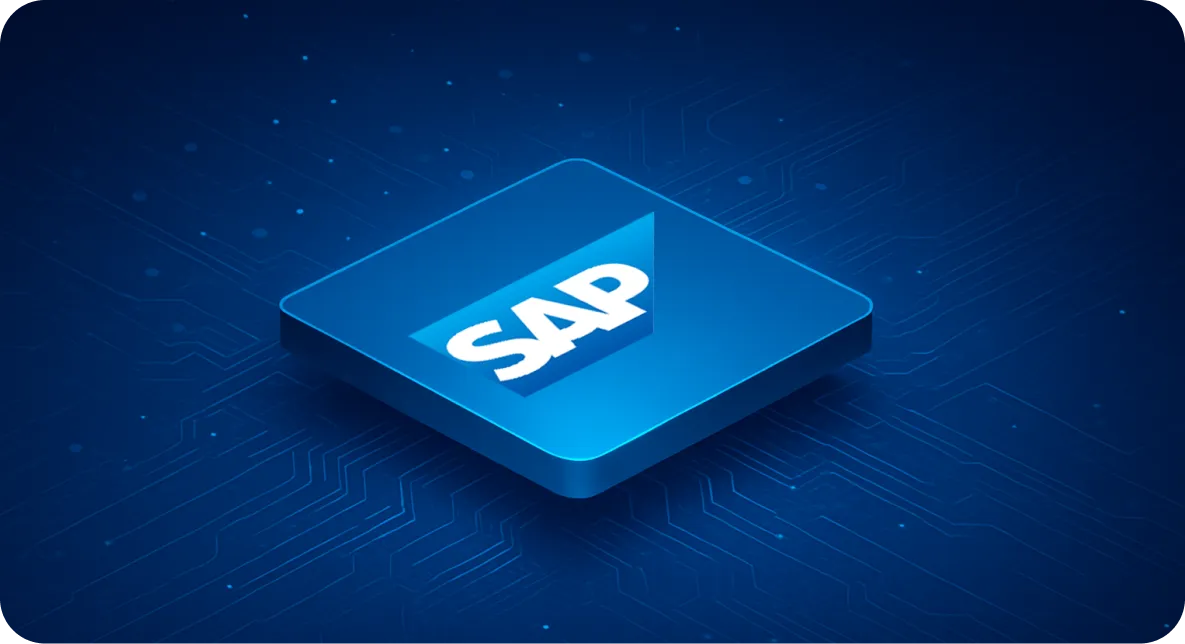
What Is SAP BTP?
SAP BTP allows organizations to leverage data for practical business strategies, encouraging the optimal use of resources within an intelligent enterprise. It brings together a wide range of technologies, applications, and services under a single platform for digital transformation.
The SAP Business Technology Platform offers a multi-cloud environment that enables teams to harness generative AI for building, automating, connecting, managing data, and analyzing insights within SAP and third-party applications.

The SAP Business Technology Platform unifies data handling, business intelligence, machine learning, software creation, process automation, and system connectivity within one unified environment.
It enables companies to gain flexibility, create business impact, and drive innovation by connecting, extending, and unlocking value from all SAP and external applications and data resources, helping enterprises become more intelligent.
History of SAP BTP
Although SAP BTP is a relatively recent offering, it includes long-established tools, and parts of its architecture date back many years. For instance, the application development and integration component traces its roots to the SAP HANA Cloud Platform, introduced in the early 2010s.
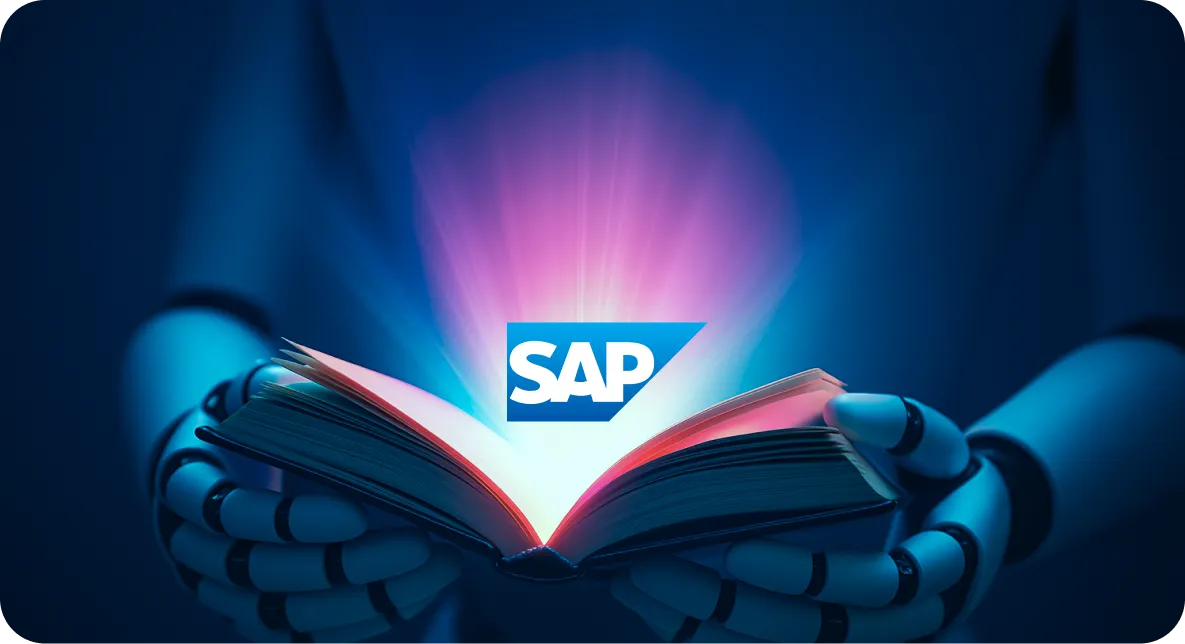
SAP officially launched BTP in 2021 when it chose to bundle different services and products into a single platform that organizations could use for strategic decision-making. The rationale behind the move was that, given the many elements involved in building an intelligent enterprise, it would be more efficient to have them delivered by a single provider instead of merging different systems. With this rollout, SAP retired the SAP Cloud Platform brand and merged its features into the SAP Business Technology Platform.
During 2021 and 2022, SAP expanded SAP BTP through several acquisitions. In July 2022, for instance, SAP revealed its purchase of Askdata to strengthen SAP BTP’s AI features, especially natural language query processing.
Recent updates to the SAP Business Technology Platform feature the launch of SAP Build Code and SAP Build Apps for low-code and no-code programming, advancements in artificial intelligence functions, and the rollout of SAP Graph.
Types of SAP BTP
SAP BTP offers two environments that share a core set of services while also providing features exclusive to each environment.
The first, known as the SAP BTP Neo environment, centers on cloud services hosted in SAP’s proprietary data centers and supports connectivity to SAP ERP systems. The Neo runtime environment supports a range of development languages, including Java, HTML5, and SAP HANA XS.
The second environment, called SAP BTP Cloud Foundry, permits users to operate from any data center and offers greater flexibility for developers and hyperscalers, such as Amazon Web Services, Google Cloud Platform, and Microsoft Azure. This setup allows developers to use their preferred programming languages, and it supports multiple runtime environments, including options for ABAP and Kyma.
The Five Pillars of SAP BTP
SAP BTP centers around five fundamental pillars that support digital innovation. Let’s explore these pillars and see how they lead to organizational success.
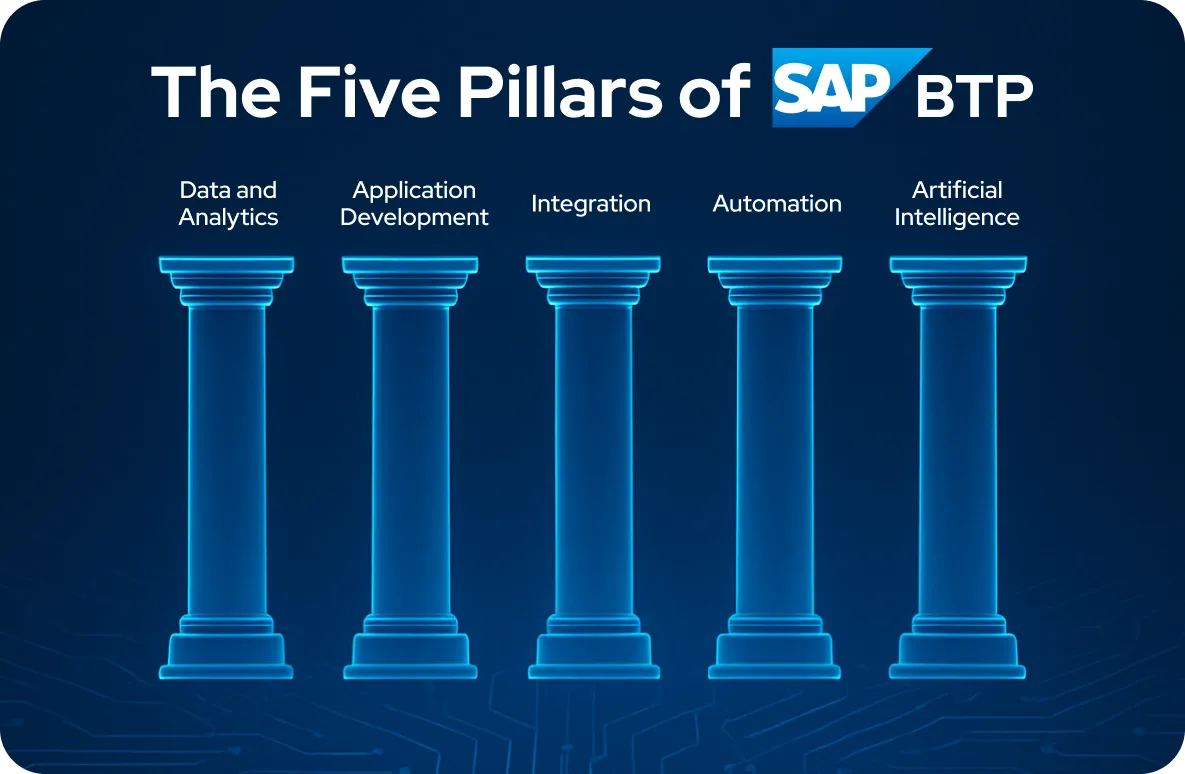
First Pillar: Data and Analytics
The data and analytics pillar emphasizes examining information, identifying patterns, and taking strategic actions based on the data imported into the platform.
The data management pillar centers on organizing, classifying, and maintaining data so users can easily access and apply it. The process includes storing, retrieving, processing, and integrating advanced analytics data between systems.
The SAP Business Technology Platform supports various methods for managing and storing data in databases, including SAP IQ, SAP Adaptive Server Enterprise (ASE), SAP HANA, SAP HANA Cloud, and SAP SQL Anywhere. You can clean, organize, and structure data using SAP products such as:
- SAP Data Intelligence
- SAP Data Quality Management
- SAP Data Services
- SAP Information Lifecycle Management
- SAP Information Steward
- SAP Landscape Transformation Replication Server
- SAP Master Data Governance.
- SAP PowerDesigner
SAP BTP permits users to carry out basic and complex data analysis using solutions such as SAP Analytics Cloud, SAP BusinessObjects BI, SAP Crystal tools, SAP Data Warehouse Cloud, and SAP BW/4HANA. By uncovering insights and trends in real time, organizations can fine-tune and automate processes, align operations with current demand, and operate more effectively using a central source of accurate information.
Second Pillar: Application Development
Application development centers on building tailored solutions and add-ons designed to meet specific business needs.
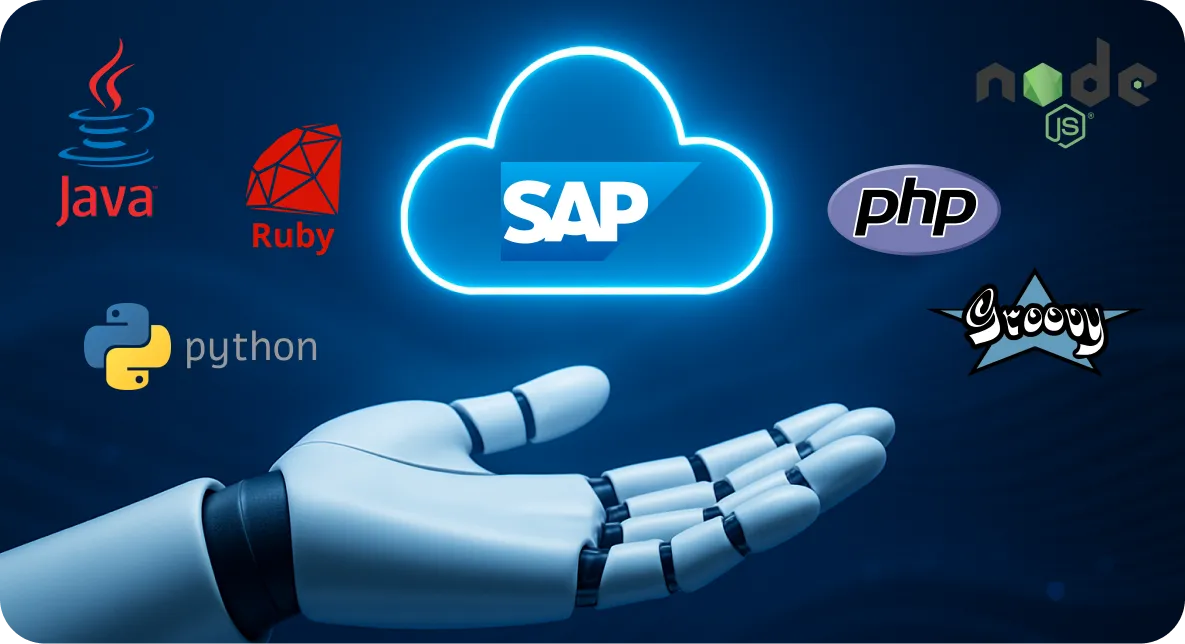
SAP BTP offers a range of business services that speed up the creation and refinement of cloud-based applications. As a language-independent platform, it lets developers work with various programming languages, such as:
- ABAP
- Go
- Groovy
- Java
- Node.js
- PHP
- Python
- Ruby
DevOps tools are also available to streamline collaboration between development and IT operations teams.
Developers can deploy SAP BTP applications and services alongside existing on-premises systems by using the SAP Integration Suite to promote smooth data sharing.
Third Pillar: Integration
The integration pillar emphasizes connecting the SAP Business Technology Platform with other SAP systems. SAP BTP delivers services that address every integration requirement within an organization. You can seamlessly integrate SAP and non-SAP solutions in cloud and on-premises environments while safely bridging systems, workflows, and users. Integration packages, APIs, business event triggers, and connectors come readily available for immediate deployment.
Fourth Pillar: Automation
Automation eliminates manual effort in routine, repetitive, and predictable tasks. SAP Build Process Automation merges workflow orchestration with tools to design forms, define decision logic, and create, modify, and manage complex business processes using intuitive drag-and-drop features. Robotic Process Automation (RPA) handles tasks in attended and unattended modes, allowing users to either assist or let the process run autonomously. Ready-to-use templates and connectors for SAP and external systems let companies implement automation quickly.
Fifth Pillar: Artificial Intelligence
Artificial intelligence (AI) centers on utilizing advanced tools to analyze large datasets, providing business insights, content creation, and process automation, thereby freeing up time for other priorities. AI and machine learning integrate into nearly all business activities, ranging from simple tasks to highly complex operations. SAP offers various AI-powered features, including SAP Conversational AI. With ready-to-use AI models, you can develop self-learning systems and design smart workflows to build your intelligent enterprise.

Popular SAP BTP Services
As of June 2025, SAP BTP offers 86 distinct services. Some of the most popular services include:
- ABAP Environment — Supports the development of ABAP-based cloud apps and custom extensions
- SAP Analytics Cloud, Embedded Edition — Enables users to explore and visualize data in connected systems
- SAP Build Apps — Facilitates low-code and no-code application creation for faster deployment
- SAP Build Process Automation — Streamlines business processes, boosting accuracy and freeing up time for strategic work
- SAP Business Application Studio — Serves as an advanced IDE for building enterprise-grade applications
- SAP Cloud ALM — Manages the deployment and lifecycle of cloud-based SAP solutions
- SAP Conversational AI — Powers the creation and training of intelligent chatbots
- SAP Data Intelligence — Uses AI and machine learning to extract insights from complex data sets
- SAP Data Warehouse Cloud — Offers scalable storage and access for data sourced from multiple systems
- SAP Graph — Merges various SAP APIs into a single, unified access layer
- SAP HANA Cloud — Delivers high-speed, in-memory database services for real-time app development and analytics
- SAP HANA Database — Acts as SAP BTP’s foundation with its in-memory architecture that processes and analyzes massive data volumes in real time
- SAP Integration Suite — Seamlessly connects various applications, platforms, and data sources on-premises and in the cloud
- SAP Intelligent RPA — Automates structured, repetitive tasks using AI and machine learning models
- SAP Workzone — Functions as the digital workspace and central access hub for business apps, files, and collaboration tools, simplifying user navigation between SAP BTP services
Benefits of SAP BTP
The SAP Business Technology Platform offers several benefits to its business users. From improved cost efficiency to increased flexibility to supported innovation, BTP rewards its clients with fully optimized, new business processes. Let’s take a look at some of the benefits of BTP.
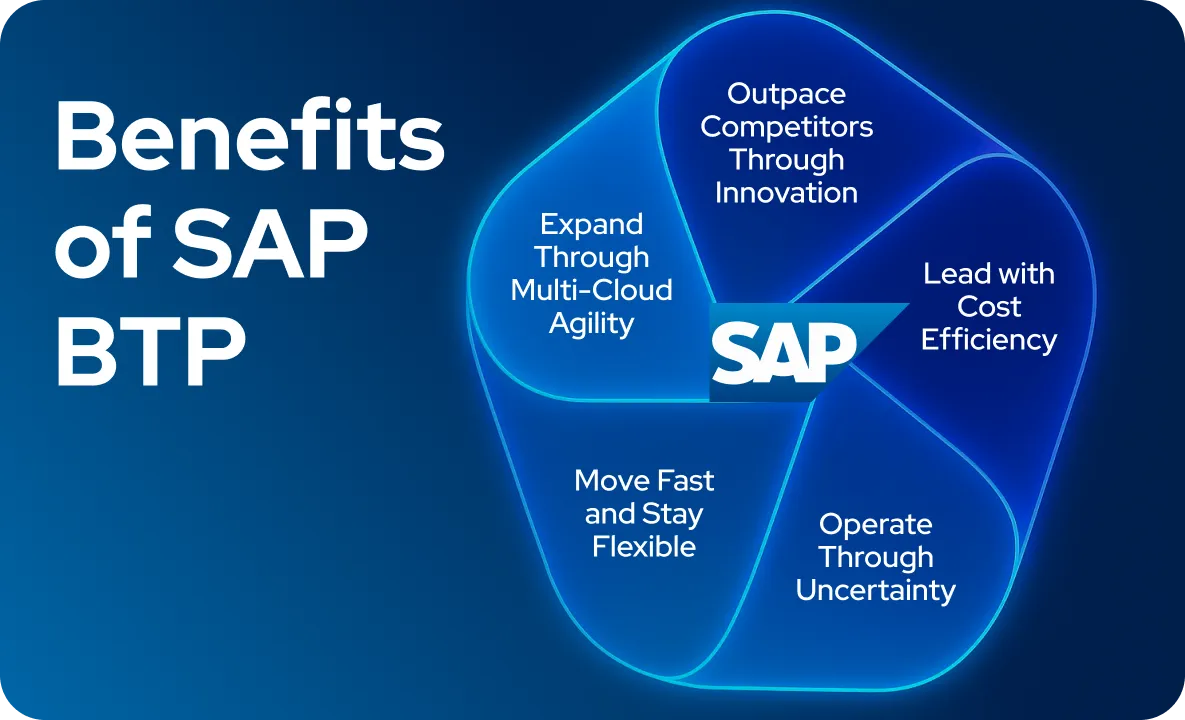
Expand Through Multi-Cloud Agility
Multi-cloud flexibility offers broad freedom in deployment, customization, and alignment with business goals and customer expectations. SAP BTP drives growth by supporting innovation and user-focused strategies within a scalable cloud environment.
Lead with Cost Efficiency
Businesses always face mounting pressure to cut expenses. By utilizing BTP and cloud-based services, organizations can ease this burden by significantly reducing the high costs tied to traditional on-premises SAP systems.
Move Fast and Stay Flexible
SAP BTP delivers flexibility and forward-thinking tools that meet shifting external demands. This benefit allows businesses to thrive in a digital market.
Operate Through Uncertainty
Change remains a constant force in the business world, making flexibility and resilience essential for navigating unpredictable times. As a cloud-hosted platform, BTP stays operational even if your internal systems face disruptions. It maintains continuous uptime, keeping your business functioning without interruption.
Outpace Competitors Through Innovation
Customer expectations shift rapidly. Introducing new ideas ahead of rivals gives businesses a significant edge. Responding to new demands often results in faster acceptance of products and services. BTP promotes rapid innovation, allowing organizations to stay on top of dynamic market conditions.
SAP BTP Pricing
Depending on the needs of your business, BTP offers several pricing options. Let’s explore the payment models for BTP, starting with the free tier.

Free Tier Access
Anyone interested in exploring BTP can take advantage of the free tier, which grants immediate entry to a live production setup. Although there are restrictions on available services and usage, this option provides a practical starting point for evaluating the platform’s potential for your business. If you choose to upgrade to a paid plan, you can smoothly transfer your existing work to the full version.
Subscription Model
The SAP BTP subscription grants access to selected services for a set price. Contracts typically span one to three years. This model suits organizations with clear use cases and defined budgets. If new services become necessary during the term, they can be included for an extra charge.
Pay-As-You-Go
Businesses exploring new workflows with SAP BTP and working within budget limits can choose for the pay-as-you-go model, purchasing only the services they require. This flexible approach allows users to avoid large upfront costs and eliminates the need to meet minimum usage commitments.
Cloud Platform Enterprise Agreement
The Cloud Platform Enterprise Agreement (CPEA) gives users flexible cloud credits they can spend on a range of SAP BTP services. This model works well for organizations that rely on multiple services but do not need them all simultaneously.
Make the Move to BTP With Cerebro SASA’s MuleSoft to BTP IS Migration
Migrating your integration workflows and configurations from MuleSoft to BTP presents several challenges and more than a few headaches. But you can automate this transition with Cerebro SASA’s MuleSoft to BTP IS Migration. To see how the Cerebro SAP AI SDLC Assist integration platform can speed up your migration, book a free demo online or call AiFA Labs at (469) 864-6370 today!




